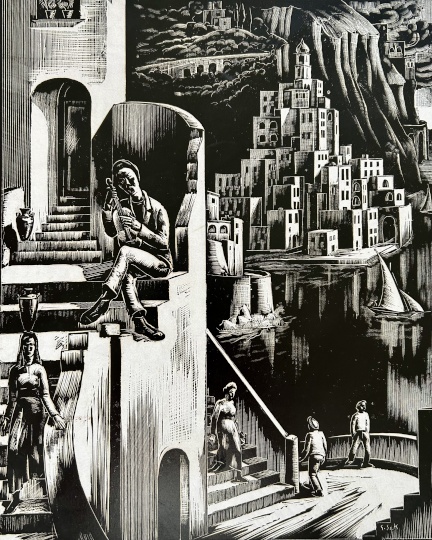Gáborjáni, Szabó Kálmán (1897 - 1955)
BiographyARTWORKS FOR SALE
WE ARE CURRENTLY PURCHASEING WORKS by this ARTIST
If you want to sell a work by this artist, you can get a free appraisal by clicking HERE »
Biography
Biography
His graphic works exhibited are mostly from 1930-1931, and are determined by the influence of his Roman experience as scholar. His themes are organized around the Italian towns’ squares and streets. Following the neo-classical solutions, his motives are characterized by the pure creation of form, the diagonal image editing and the influence of the Renaissance art.
The atmosphere of his works is calm and balanced, even if the characters are imbued with some kind of movement. The dynamic of his precise woodcuts are determined by the black and white surfaces contrast. His figures are inspired directly from the Renaissance paintings and from everyday surroundings. Later works influenced by the Hungarian rural life show the his previously developed style. He made several series of illustrations and advertising graphics as well.
| Year | Biography |
|---|---|
| 1897 | He was born in Debrecen |
| from 1922 | Hungarian Academy of Fine Arts |
| 1922 | Art teacher in the Reformed College of Teacher Training Institute |
| 1944-1945 | He was director in the college |
| He worked at the Ministry of Culture for a short time, then became a teacher at the Hungarian Academy of Fine Arts | |
| He was a member of the New Artists Association and the Engravers Association of Hungarian Artists | |
| His teachers: Imre Révész, János Vaszary . | |
| Awards | |
| 1930-1931, 1938-1939 | the Scholarship of the Hungarian Academy in Rome |
| 1922 | the Szinyei Society Scholarship |
| Single exhibition | |
| 1967 | Bakonyi Museum, Veszprém |
| 1966 | Déri Museum, Debrecen |
| Hungarian National Gallery, Budapest | |
| 1955 | Adolf Fényes Hall, Budapest |
| 1930 | Scherlhaus, Berlin |
| 1923 | City Hall, Debrecen (with László Félegyházi) |
| Selected group exhibitions | |
| 1983 | Roman School I., Christian Museum, Esztergom. |
| 1977, 1978 | Hungarian National Gallery, Budapest |
| Szolnok Gallery, Szolnok | |
| The Szolnok Art Colony jubilee exhibition, János Damjanich Museum | |
| 1955 | Our ten years of Fine Arts, Palace of Arts, Budapest |
| 1950 | I. Hungarian Fine Arts exhibition, Kunsthalle, Budapest |
| 1948 | Exhibition of Rippl-Ronai Society, National Salon, Budapest |
| 1941 | 94. group exhibition, National Salon, Budapest |
| 1935 | Lvov |
| Oslo | |
| 1934 | Amsterdam |
| Hague | |
| 1933 | Chicago |
| Cleveland | |
| 1932 | Chicago |
| 1930's | Los Angeles |
| Philadelphia | |
| 1931 | the Hungarian Engravers Artists Assocatiation exhibition |
| 1935 | the Hungarian Engravers Artists Assocatiation exhibition, National Salon, Budapest |
| 1932 | International Religious Art exhibition, Padua |
| XVIII. Venice Biennale, Venice | |
| 1931 | The first exhibition of the Roman-Hungarian Institute scholar artists, the National Salon, Budapest |
| 1929 | Kunstgemeinschaft, Vienna |
| 1928 | Ernst Museum, Budapest |
| Switzerland | |
| 1926 | Ernst Museum, Budapest |
| Művek közgyűjteményekben | |
| Déri Museum, Debrecen | |
| János Damjanich Museum, Szolnok | |
| Petőfi Literary Museum, Budapest | |
| Hungarian National Gallery, Budapest | |
| János Tornyai Museum, Hódmezővásárhely. | |
| Janus Pannonius Museum Modern Hungarian Gallery, Pécs | |
| Public works | |
| Mural painting (mural, 1938, Debrecen, Reformed College) |











